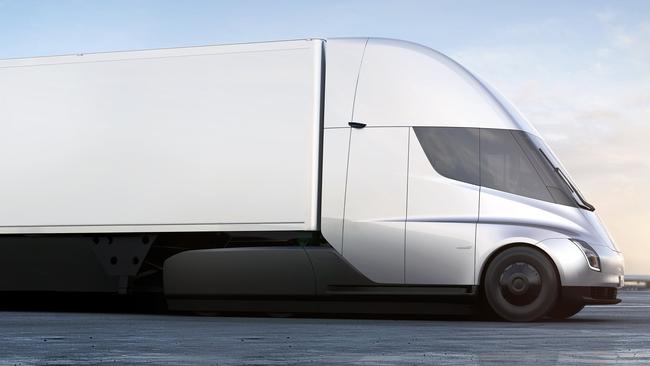Outdated truck rules carbon-cut roadblock
Australia risks being a late adopter of low-emissions electric and hydrogen trucks currently outlawed under outdated heavy vehicle regulations.

Australia risks being a late adopter of low-emissions electric and hydrogen trucks currently outlawed under outdated heavy vehicle regulations, with Tesla and the Australian Trucking Association demanding the rules be brought into line with the rest of the advanced world.
The roadblock to early adoption of low-emissions heavy vehicles has emerged as a significant barrier for the government’s Future Fuels Strategy, with US and European manufacturers developing trucks according to local standards.
Under current vehicle design standards, Australian heavy vehicles have a width of 2.5m, compared to Europe (2.55m standard and 2.6m refrigerated trucks) and 2.6m in the US.
In its submission to the National Transport Commission, Tesla Motors said the “clearest immediate barrier” was Australia’s 2.5m width limit.
“The Tesla Semi is likely to be wider than permitted under this regulation by just 30-50mm. The US allows 2600mm heavy vehicles and the EU 2550mm,” the Tesla submission said.
“The commission will be aware that given Australia’s small size in comparison to global markets, inconsistencies like this between Australian regulations and larger markets will delay or preclude vehicles coming to local markets.
“Currently, Australia will likely miss out on the first generation of electric heavy vehicles such as the Tesla Semi because of this. Beyond the direct carbon emissions impact (of) this in the short term, this outcome would delay and stunt Australia’s broader uptake of electric heavy vehicles.”
With transport identified as the second-largest, and fastest-rising, source of carbon pollution in Australia, Tesla said the “rapid decarbonisation of Australia’s heavy vehicles is an urgent imperative”.
The ATA, representing 50,000 businesses and 200,000 employees, said the federal government “should lead amendments to vehicle design standards”, including increasing maximum vehicle width to 2.6m.
ATA chief executive Andrew McKellar said while most Australians had some awareness of the potential of electric cars, few would realise the opportunity of EVs and hydrogen across the road freight sector.
“From our point of view, we are getting to the stage now where a number of international vehicle manufacturers are bringing electric vehicles to the market,” he said.
Mr McKellar said to encourage the uptake of alternative powertrains, the government must ensure vehicle standards regulations were “flexible enough to allow that to happen”.
“We have identified with officials there needs to be flexibility in the vehicle standards regulations for a slightly wider dimension of vehicle,” he said.
“It’s really just a matter of getting in front of the curve … ensuring vehicle design regulations are flexible enough.
“Vehicles (will) have to be imported from Europe and the US predominantly.”
“The way forward in terms of having a long-term impact on carbon emissions is to open up alternative powertrains, and electric and hydrogen are going to be part of that solution.
“We just want to ensure there are not regulatory barriers in place.”




To join the conversation, please log in. Don't have an account? Register
Join the conversation, you are commenting as Logout